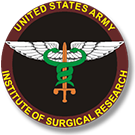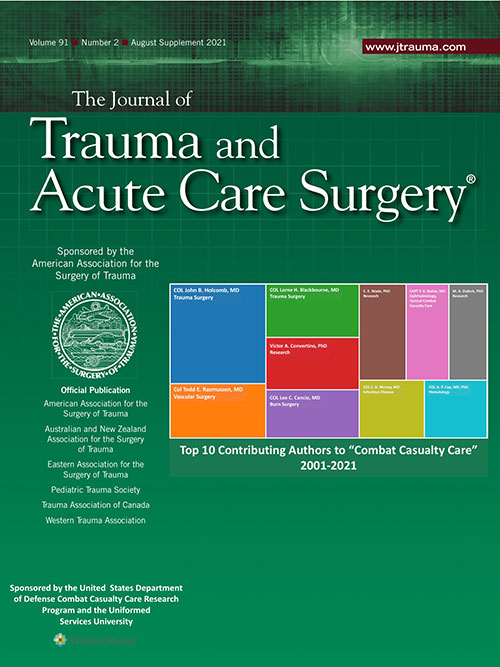8 of 10 Top Contributing Authors to a Premier Scientific Journal are from USAISR
Combat casualty care research at the U.S. Army Institute of Surgical Research (ISR) at Joint Base San Antonio-Fort Sam Houston, Texas, has been focused on saving the lives of Wounded Warriors since 1996. From hemostatic dressings to tourniquets and blood products to damage control resuscitation, ISR researchers' efforts have demonstrated a steadfast commitment to advancing the care of combat wounded service members.
For more than two decades, some of ISR's most noteworthy contributions to combat casualty care research have been submitted and published in the Journal of Trauma and Acute Care Surgery (JTACS), a scientific journal dedicated to publishing the most important and impactful manuscripts related to combat casualty care. More recently, the journal has published an annual supplement dedicated specifically to combat casualty care in order to further highlight these types of scientific articles for clinical use. This year's JTACS Military Supplement, released in August, highlights the top ten contributing authors to combat casualty care manuscripts from 2001-2021; eight of which are current or former staff members at the ISR.
"This is the premier scientific journal for the discipline of trauma surgery," said Dr. Jeremy W. Cannon, SM, FACS, Professor of Trauma, Surgical Critical Care and Emergency Surgery at the University of Pennsylvania and one of three co-editors of the JTACS 2021 Military Supplement. "It has a broad scope in that it not only covers topics related to the surgical management of severe injuries but also the critical care management, as well as non-trauma surgical emergencies."
Cannon, a colonel in the Air Force Reserves, along with Navy Capt. (Dr.) Travis Polk, Director of Combat Casualty Research Program at the U.S. Army Medical Research and Development Command, and Col. (Dr.) Andre Cap, Director of Research at the ISR, were co-editors of the supplement.
"Eight of the top ten contributors to combat casualty care were ISR investigators," said Cap. "The other two were close collaborators of ISR investigators. I think it's fair to say that ISR as an institution is pre-eminent in the field of combat casualty care."
Cap also noted that Cannon performed the analysis on Web of Science and built the cover graphic highlighting the top ten contributors. Cannon's query identified a total of 1,768 manuscripts submitted and published in the JTACS, the majority coming from the ISR.
"The ISR has quite frankly been the driving force behind this dedicated supplement that grew out of the historic ATACCC meeting [Advanced Technology Applications for Combat Casualty Care Conference now known as the Military Health System Research Symposium]," said Cannon. "The ISR continues to send some of their best scientific work to the journal for peer review and possible inclusion in the supplement every year, and without a doubt, these contributions have greatly bolstered the impact of this supplemental issue."
Retired Army colonel Dr. John B. Holcomb, FACS, took command of the ISR in 2002 while the U.S. and its allies were involved in combat operations in Iraq and Afghanistan. Serving as both the ISR commander and the Surgeon General of the U.S. Army's Trauma Consultant for his six years at the ISR, Holcomb deployed multiple times to the battlefield; experiences which, according to Holcomb himself, were vitally important in injecting a sense of urgency into the research laboratory culture.
"Bleeding to death was the primary cause of preventable death on the battlefield," said Holcomb. "With the help of many, we were able to focus efforts on mitigating the primary cause of preventable death, deploying multiple interventions that addressed all aspects of hemorrhage control.
"There was a well-articulated focus on publishing relevant papers focused on the current war effort across our entire command. This ensured that deployed providers at all levels of care would have the latest information and apply it to the casualties they were caring for, as well as preserving the thought process for future efforts in combat casualty care."
Before taking over as the ISR's research director, Cap led the Coagulation and Blood Research team that focused research to develop products and approaches to resuscitate combat casualties. He believes the ISR provided – and still provides to this day – an environment in which motivated researchers can flourish and advance the field of combat casualty care.
"This unique environment attracted researchers who wanted to be change agents and advance the field," said Cap. "I was fortunate to lead an extremely talented and hard-working team of scientists at ISR. I am extremely grateful for the opportunity to have taken part in this historic work."
Cannon stated that the combat casualty care research at the ISR represents a vital link in the chain of survival for combat casualties.
Said Cannon, "Without the careful, thoughtful analysis of our results to identify capability gaps and then the innovations needed to fill those gaps, we would not be able to deliver the improvements in combat casualty prevention and care that are so vital to the supremacy of our fighting force."














